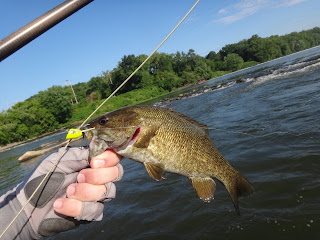The good news for me is that I have family near the coast, and they make a perfect staging point to hit the back bays along the Maryland and Virginia Coasts...and it's nice to seem them as well:) One of my goals this year was to try and catch a flounder off the fly. Obviously, flounder are not the most targeted fish off the fly, but they are catchable, and even a small flounder could be fun off the long rod.
There are two strategies for targeting flounder with the fly. The first is to stick to the shallows, and use weighted flies. This permits the use of a floating line, while still being able to get the fly into the strike zone. Of course, this means there will be a limitation in the habitat and waters that will be fishable. To overcome this, a sink tip, or even a full sinking line will be required. For me, I will be using a full sinking line. This allows me to fish all zones of the back bays; allowing me to target not only bottom dwelling fish like flounder, but also the mid and upper levels of the water column. Remember, even though the line may sink, the moment you start stripping, the fly will come alive. This still allows casting into breaking fish, with the added advantage of hitting the top of the boil, as well as allowing the choice to let the fly to sink to where larger fish may be lurking.
As for flies, the usual saltwater suspects apply. Think clousers, deceivers, half-n-halves, but shrimp and squid patterns are also useful. Granted, tying an all white clouser or deceiver may do a decent job of imitating a squid, and tying either in pink colors is a decent soft shrimp imitation (they are pinkish when they shed their shell), but having an excuse to tie something new is more than enough for me to have to break out the fly tying kit.
 |
| Tying a squid fly is a nice change from the typical trout and bass flies |
For shrimp patterns, I decided to try my hand at the crazy charlie. This is one of THE patterns for bonefish, because it imitates a small shrimp or crustacean...hey, that sounds good enough to me. I did tie mine a little larger than the average charlie, and added some colors that more closely match the shrimp in the back bays where I fish, including some touches of pink for one of the flies. Believe it or not, pink can sometimes be the only color flounder will hit, and therefore I always make sure at least one of my flies incorporates this hue.
 |
| Some of the crazy charlies I tied for flounder |

